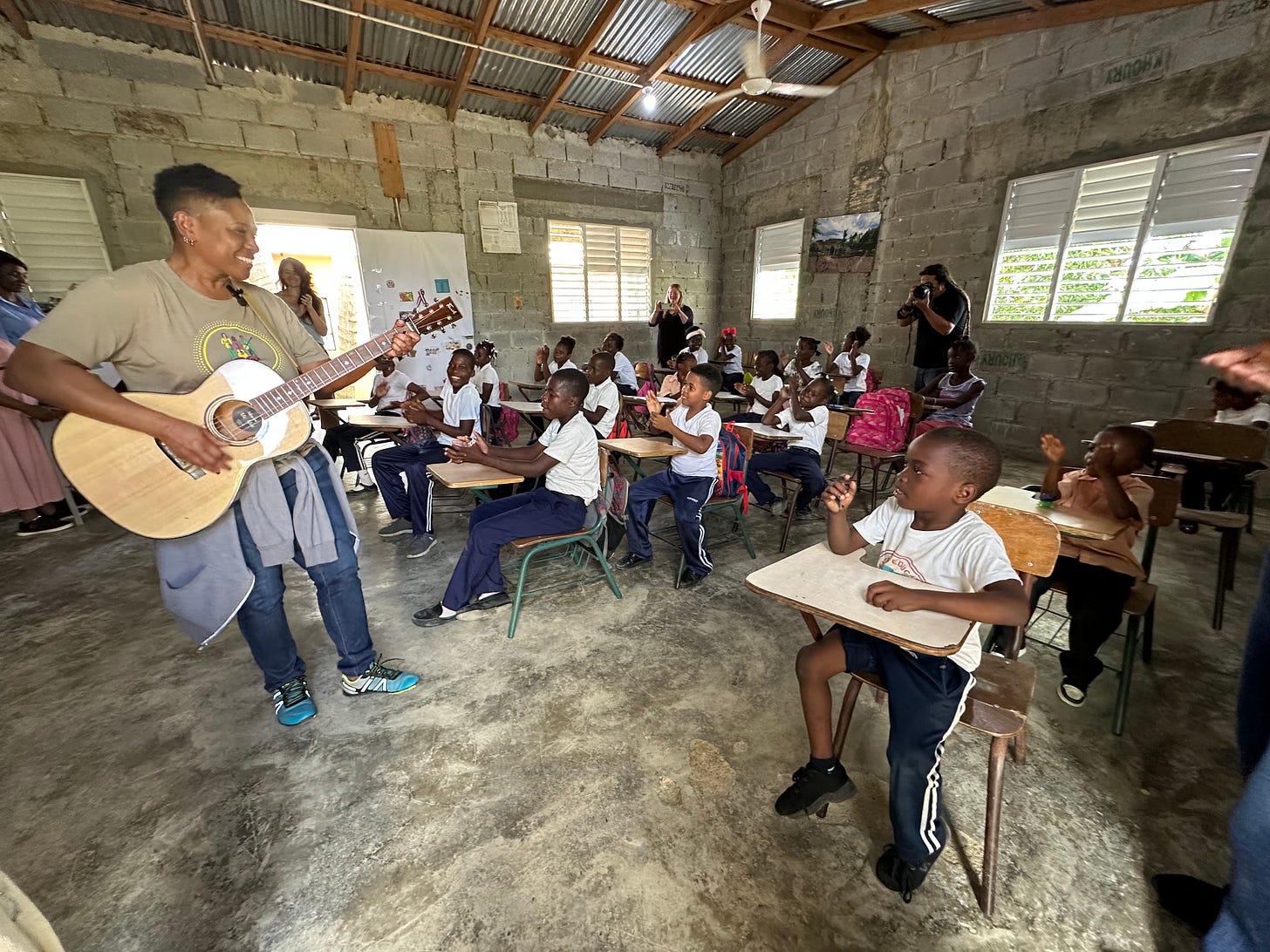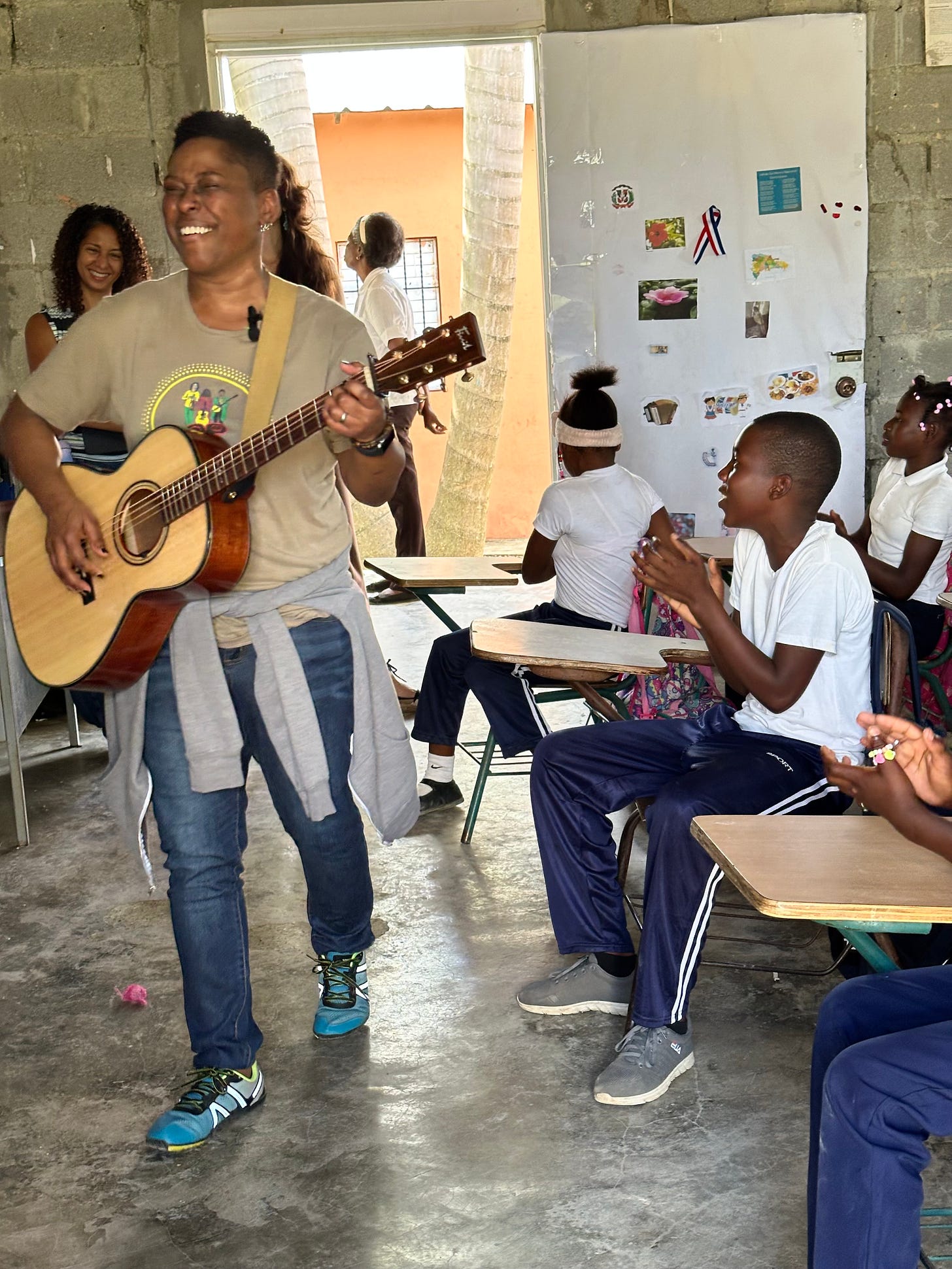I’m still reflecting on my trip to the Dominican Republic with American Jewish World Service. There’s so much to say and even more I’m still processing. But right now, this is what’s on my mind.
Spending the past week in the Dominican Republic, immersing myself in its history, has made one reality painfully clear: history is often shaped just as much by what is erased as by what is remembered.
The Dominican Republic, like so many places, tells a story that is both beautiful and haunting. Beneath the vibrant music, the breathtaking landscapes, and the warmth of the people lies a deeper, more painful history—one of colonialism, forced assimilation, and the erasure of Indigenous and Black histories.
The Taíno people, the original inhabitants of the island, were nearly wiped out through conquest and disease, their stories often reduced to a footnote in history books. The descendants of enslaved Africans, who built so much of this land, have struggled against systems that have sought to make them invisible. And yet, despite centuries of attempts to erase these narratives, their presence, resistance, and culture remain.
And then there is the more recent erasure—one that speaks to the deep entanglement of racism and statelessness. In 2013, a Dominican new law stripped citizenship from thousands of people of Haitian descent, rendering them stateless in the country where many had lived for generations. Without documents, they became ghosts in their own land—unable to work, travel, or access education and healthcare. This is not just history; it is happening now. A system built on anti-Blackness and colonial legacies continues to push people to the margins, determining who belongs and who does not.
I saw parts of the Dominican Republic that tourists never see. I walked through the bateyes—shantytowns built around sugar mills in the early 20th century to exploit Haitian laborers who were brought to the Dominican Republic to cut sugarcane. These communities were intentionally designed to isolate Haitian immigrants, keeping labor costs low while ensuring they remained separate from Dominican society. Though the sugar mills are long gone, these communities persist, still marginalized and deprived of basic state services like water, electricity, and education—evidence of the lasting impact of systemic exclusion.
Despite this lack of resources, the people in these communities have built schools, started businesses, and continue to advocate for the elderly, fighting for the pensions they deserve. Their resilience is evident in the ways they sustain themselves and support one another. One of the most powerful moments of my trip was singing with the children at their school—my guitar in my hands, their voices rising in joy, reminding me that even in hardship, music remains a source of strength and hope.
Even in the face of racism and being forgotten by the government, the people caught up in statelessness remain resilient, refusing to be erased. I want to be clear: these people are Dominican, caught in a system that unjustly removed their citizenship by rewriting the constitution to revoke the citizenship of people of Haitian descent.
I’m also thinking about the Black Doll Project, which affirms Black identity and challenges the deep-seated anti-Black beauty standards that have long devalued Black features, leaving many Black children, especially girls, feeling unworthy. I met with an organization of LGBTQ activists, and I saw the tears of joy in their eyes as we left, having honored their work and their presence. In a place where erasure is so deeply embedded in the system, simply being seen—being acknowledged—was a powerful moment of connection and solidarity.
It is a story that feels deeply familiar.
As a Black, Jewish person living in America, I know what it means to have your history rewritten or ignored. I know how institutions can decide which stories are worth preserving and which are too inconvenient to acknowledge. I know how easy it is to celebrate the contributions of a people while refusing to reckon with the injustices they endured.
Jewish tradition teaches that remembering is sacred. Zakhor—remember. We recite this word in our prayers, our holidays, our rituals. We tell the stories of our ancestors not just as an act of remembrance, but as a declaration of presence.
But what happens when remembering is an act of resistance?
I think about the parallels between the erasure of Black and Indigenous history in the Dominican Republic and the ongoing struggles in the U.S.—from the banning of books that tell the truth about slavery and segregation to the whitewashing of civil rights figures who were once considered radical. I think about how even within Jewish spaces, stories of Jews of Color, Sephardic, and Mizrahi communities have often been marginalized in favor of a singular narrative.
And I think about the responsibility we have—not just to remember but to reclaim.
History isn’t just what’s written in textbooks—it lives in the voices of those who refuse to be silenced. It is what lives in the songs, the prayers, the languages that refuse to disappear. It is in the quiet resistance of those who speak their ancestors’ names aloud. It is in the art, the rituals, and the stories passed down in whispers and in song.
So this week, I want to leave you with a question: What stories do you carry that the world has tried to erase? And how will you make sure they are remembered?
With gratitude,
R’ Sandra




I'm so moved by this piece, and I learned a lot too -- about some important history I hadn't known, and about the nature of enduring stories. Your essay also made me remember something I learned in rabbinical school in my Kabbalah (Zohar) class -- that Jewish mystical texts are really fascinated with questions of what is revealed and what is concealed. In many of those texts, that which is concealed takes extra work to bring into visibility, though that which is concealed has a tendency to keep peeking out through cracks and openings if we pay attention. It's holy work to strive to see and affirm that which is concealed -- doing so with care helps create cosmic repair. Just a little mystical twist that came to mind reading your beautiful piece.
So beautiful Rabbi, thank you for sharing. I’m remembering my trip to the Dominican Republic and my conflicted feelings as I enjoyed my “eco vacation” and observed the harsh reality of extreme poverty. Such a brutal history.